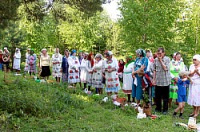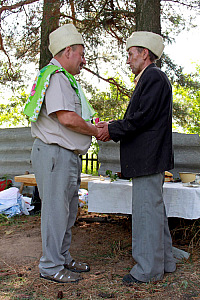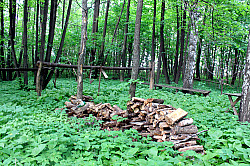 More than 50 worshippers gathered in a sacred grove on a hot June afternoon outside the village of Marisola. The crowd, mostly women dressed in national costumes and colorful headscarves, stood on a glade opposite a spruce where men were busy conducting prayers.
More than 50 worshippers gathered in a sacred grove on a hot June afternoon outside the village of Marisola. The crowd, mostly women dressed in national costumes and colorful headscarves, stood on a glade opposite a spruce where men were busy conducting prayers.
The congregation kneeled while the men under the spruce, dressed in suits, white felt hats and linen towels cast over their shoulders, said prayers in a low, monotone murmur.
They prayed to Osh Kughu Yumo — Mari for “Great White God” — who was being revered that day as Agavairem, which means both deity of creative energy and the feast marking the end of spring labor.
The women lined up in the grass in front of piles of thick homemade pancakes, white cheese, dumplings and brown kvas, the fermented rye drink. Pots and kitchenware were adorned with burning candles, as was a makeshift table in front of the spruce.
The extraordinary ceremony testified to the little-known fact that an animist faith has survived centuries of Christian and Muslim hegemony in this obscure region 800 kilometers east of Moscow.
The Mari, a Finnic people of roughly half a million whose language sounds a bit like a strange mixture of Finnish and Turkish, are said to be Europe’s last pagans. Yet their priests, called kart in Mari, reject that notion.
“We are not pagans. We call our faith the Mari Traditional Religion, and we are registered officially in the republic,” said Vyacheslav Mamayev, who oversaw the ceremony as the chief kart of the local Sernur district.
He went on to explain that for the Mari, God has nine substances, or hypostases, ranging from the life-giving Ilyan Yumo to the birth goddess Shochinava.
Asked about the theological foundation of his faith, Mamayev smiled and said, “Everything works through nature.”
 Indeed, like most animist religions, the Mari faith traditionally knows no written scriptures and no sacred edifices. Prayers are chiefly held in sacred groves, where some feasts include the ritual slaughter of animals as sacrifice.
Indeed, like most animist religions, the Mari faith traditionally knows no written scriptures and no sacred edifices. Prayers are chiefly held in sacred groves, where some feasts include the ritual slaughter of animals as sacrifice.
“Nature is our temple,” said Zoya Dudina as she walked with worshippers on a winding path through high grass after the ceremony in the grove had ended.
Dudina, a poet and intellectual from the republican capital, Ioshkar-Ola, expressed pride that her people had regained the possibility to practice their traditional faith.
In Soviet times, she said, villagers would sneak out to the sacred groves after midnight, hoping that nobody would report their forbidden prayers.
Indeed, unnoticed by much of the outside world, the Mari faith has made a remarkable recovery since the end of Soviet Union.
In Marii El, the Mari Traditional Religion, dubbed MTR, is recognized as one of three traditional faiths, along with Christianity and Islam.
The Mari High Kart Alexander Tanygin regularly attends official ceremonies alongside local Christian and Muslim leaders.
About 15 percent of the people of Marii El consider themselves adherents of MTR, according to a survey conducted in 2004 by Sociologists of the Mari Institute for Language, Literature and History. Because Maris make up just 45 percent of a population of 700,000, this figure means that probably more than a third of them follow the old religion.
Even local Orthodox clergy acknowledge the traditional faith’s dominance in the republic’s northern rural districts.
“This is certainly the weakest parish in all of Marii El,” said Father Sergy of Marisola’s Pokrovka Church.
Of the local population of 2,500, only 10 to 15 believers attend his services regularly, he said, standing outside his small 19th-century church.
In the local district center of Sernur, the Eparchy of Marii El is building a new church, but construction, which began in 2003, has stalled because of a lack of funds.
Yet Father Sergy, a gaunt man with a scrubby beard and a kind voice, made it clear that he bore no grudge against the pagans. “We have friendly relations. We are not foes,” he said.
He noted that about 1,500 locals were baptized, although he added that he considered practicing traditionalists to be lost souls. “They have no hope of being saved — that can only happen to believers,” he said.
The Mari faith is no isolated phenomenon and has been described as syncretic, combining elements from various religions.
Many Mari villagers have icons in their homes, and drivers stick miniature images of saints on their dashboards, just like anywhere else in Russia.
 On their way out of the grove at Marisola, women turned around and crossed themselves, just as Orthodox believers do when leaving church. When one of the karts saw them, he mildly told them to stop.
On their way out of the grove at Marisola, women turned around and crossed themselves, just as Orthodox believers do when leaving church. When one of the karts saw them, he mildly told them to stop.
“You should not put too much significance in this,” Dudina explained. “Our people have lived with the Russian church for generations, but our faith is older.”
Christianity, she said, had not entered Mari rites, but rather the rites had entered Christianity. “There are so many pagan traditions in Christianity. Look at the Christmas tree,” she said.
Other Mari classify themselves in groups with varying degrees of Russian-Orthodox influence, including “Rush Vera” followers, who might even go to church at times; followers of “Marla Vera” who are baptized; and the nonbaptized “Chi Mari.”
Mamayev, the Sernur district kart, said the various groups should be allowed to coexist. “Many who come to our prayers are baptized. We will not exclude them. Everyone should be allowed to pursue his own form of worship,” he said over a traditional meal of pancakes and kvas held in the Marisola village after prayers.
Juha VКliaho, a Finnish Lutheran missionary who worked in Marii El for 10 years before moving to Bashkortostan, estimated that 60 percent of the Mari are baptized into the Orthodox Church. “But in their hearts, they are all pagans,” he said in an interview in the Finnish Lutheran Church in the outskirts of Ioshkar-Ola, the capital.
The city of 280,000 displays few signs of animist traditions. More striking here is the Orthodox Church’s construction activities, which can be seen at numerous churches and religious schools.
VКliaho said that while traditions are strong in the villages, pagan structures are weak in the city.
“It is a totally rural phenomenon. You don’t really hold on to these beliefs in a city,” he said.
Asked about the local success of missionaries, he said the Lutheran parish in the capital had more than 150 members. Despite the low numbers, he mused that Protestants might be more successful in proselytizing here than the Orthodox. “Many Mari do not want to go the Orthodox church because it is perceived as quintessentially Russian. We, however, can offer worship in their own language,” he said.
Even Father Sergy, the Orthodox priest in Marisola, suggested that he did not see much sense in his church winning over the traditionalists. Asked about the future of the Orthodox faith in Marii El, he said he did not worry so much about paganism but rather about people with no faith at all.
“Look at the youth in our villages,” he said. “They have little hope of finding work. They either start drinking or move away to the cities, where they find all sorts of bad things but no religion.”
Nikolaus von Twickel,
MARISOLA, Marii El Republic
Source: The Moscow Times

Thank’s – interesting things !
In eighties people were demonstrating against russian occupation of Estonia and Balticum in general in Helsinki and otherwise working for Estonia and Ingria and Mari El. Nowadays there is maybe less interest for our brothers in Russia ? They certainly need our solidarity.
A lion kills a cow for its food. It is a natural act.Do we worship the lion for its nature? All natural things in nature we accept, but some we will not approve. When one says he or she worships nature, then some things of nature which they do not approve, also they worship. This is not being truthful to one self. Nature is to be preserved not worshipped. Worship the creator not the created. People turn away from their Creator because of “guilt” on things they do.This is the reason why The good GOD send his son Jesus Christ for us. Take courage & believe in Him, for He will help you in your guilt, which you yourself or none can.
I worship a wolf god. I accept every aspect of nature even that which my limited human mind labels evil.
May be it’s true to say, that we worship sacred natural sites, special places in nature with special traditional habits, not exactly that we worship everything in nature.
Arvi,do you guys have contact with other animistic religions followers outside your country? I ask this because I´m both a Taoist and a shamanist and have heard that in the US (and elsewhere in Europe) shamanists from many countries have held gatherings to meet each other and exchante experiences,fostering more union amongst shamanists.
I forgot to say,not only the US and Canada native shamanists are getting together adn inviting shamanists from Altaic countries but also city practitioners attend lectures such as given by Mongolians shamanesses ,Sarangerel in the US.Also,
there are Bön Tibetan religion branches in the US/Canada and European countries as well and their religion has strong shamanic elements and lucid dreaming practices,as many animistic religions have.
Pingback: Reisebericht
The headline is not quite accurate, as there are other people practicing the Old Religion in Europe, a few in unbroken lineage, but mostly as re-constructionists. Thank you so much for this article.Those of us who are desperately trying to put back together the fragments of our broken lineages only have the genetic memory deep in our bones to guide us. We sift out the Pagan elements from Christian rituals in hopes that we are “getting it right” and look for any other fragments of clues that weren’t burned and destroyed along with the people who lived them .It is so helpful and inspirational for us to learn of people like the Mari who have been practicing the Old Ways from time immemorial to the present
Pingback: The Priest Speaks | Souciant
Thank you for this good article. I want to know more. I am 100% Finnish blood in America. My Grandparents came to America in 1900. I am studying to learn Finnish. I want to compare the Mari language to Finnish.
I am wondering if someone from this blog could guide me in the right direction. I am currently training as a soul midwife, someone who gives non-denominational spiritual support to people who are dying.
As part of an assignment I have been asked to research and write a brief paper on a particular indigenous culture or faith group (i.e. Native American, Paganism, Buddhist, etc.) and research how the elements of Earth, Water, Fire and Air are significant to that group. Additionally, I am asked to try to discover how that group works with these elements in relation to death.
I have had an interest in the Mari Traditional Religion for a number of years and would like to do my research here. While information online is more extensive than when I first discovered information about the Mari religion over a decade ago, specific information about how the Elements are used is not so clear.
If at all posible, could someone here either answer questions or point me in the right direction to discover this information? I can be reached via the blog linked to with my name.
Many thanks in advance.
I am a Finnish/American. I enjoy all the comments people from around the world say here in this blog. I am so very glad , so thankful, to be on the earth at this time. I am studying the Finnish language so I can compare it to the Mari-El. I am learning the Cyrillic alphabet so I can know some Russian. I want to visit the Mari-El.
Pingback: Moscow Times: The Mari People, Europest’s Last Pagans( Estonians Are Related To The Mari’s And Their History Is Written In Estonian)LOL! | Ann Novek--With the Sky as the Ceiling and the Heart Outdoors
Reblogged this on Vanaland and commented:
Europas letzte Heiden, echt cool